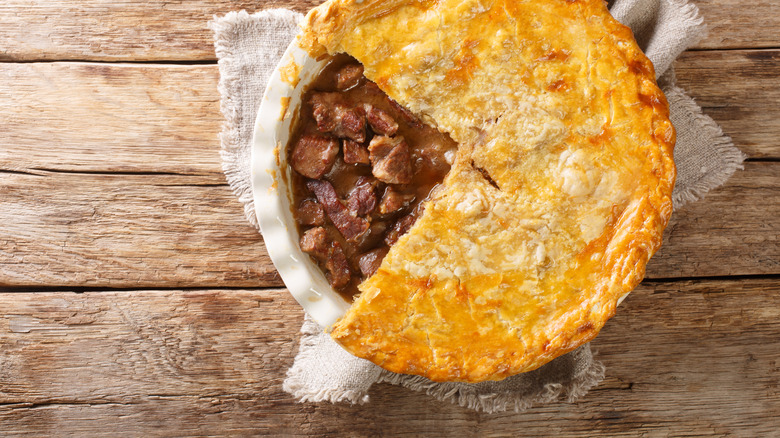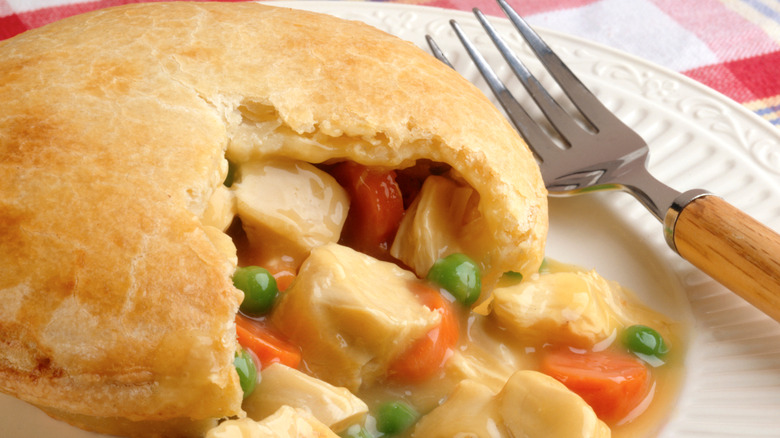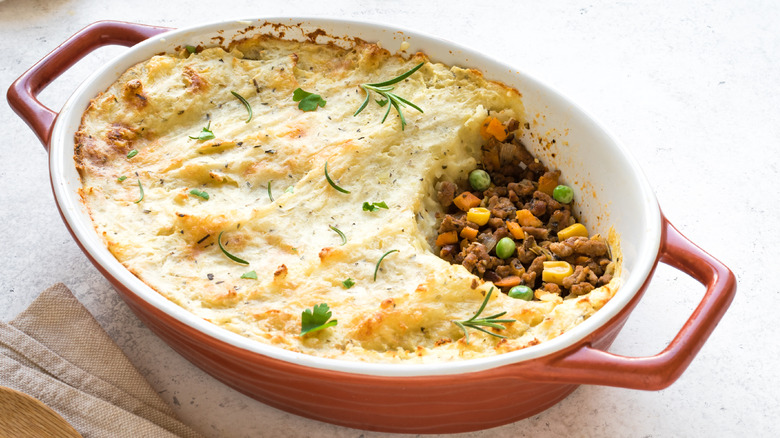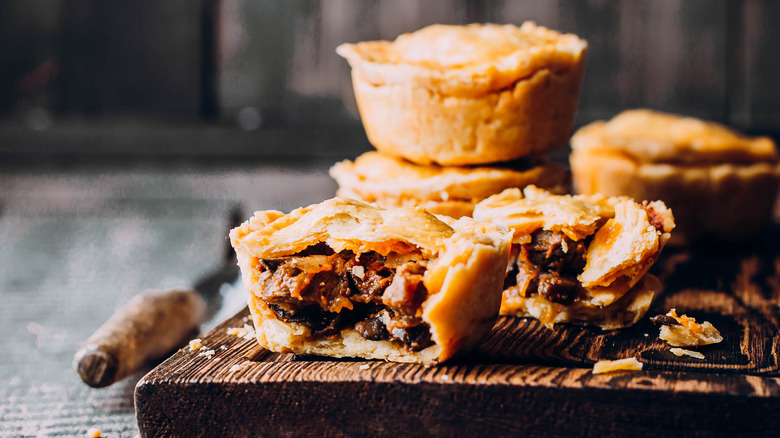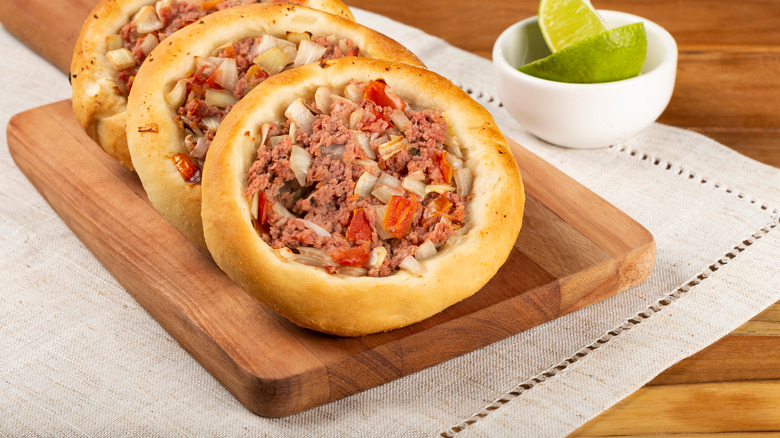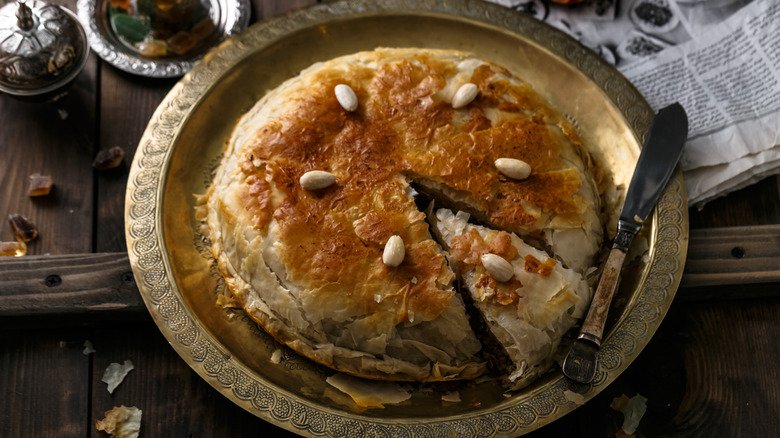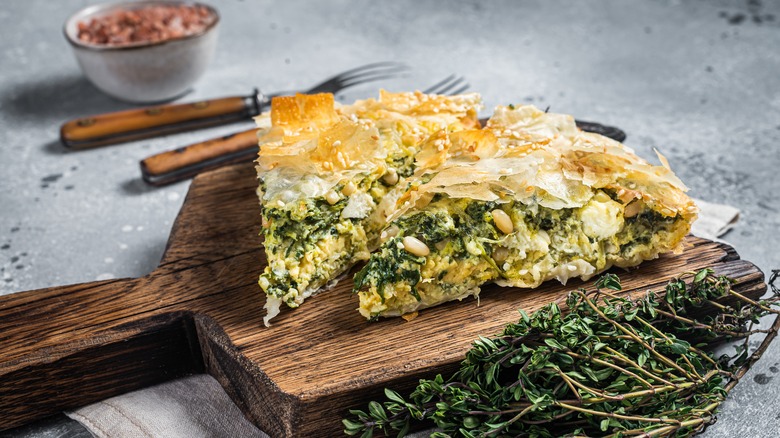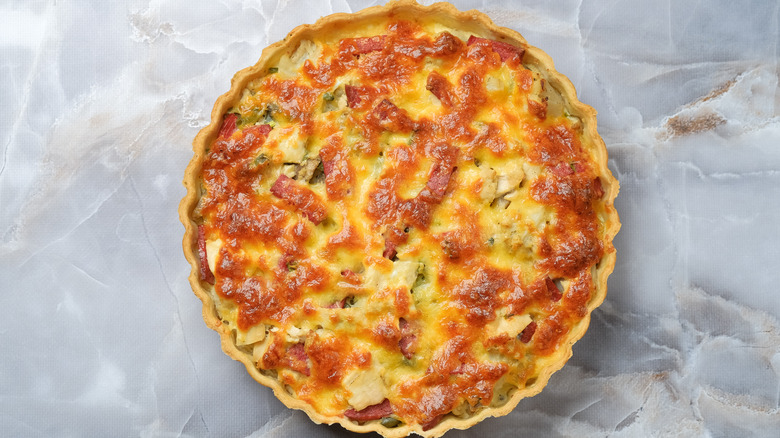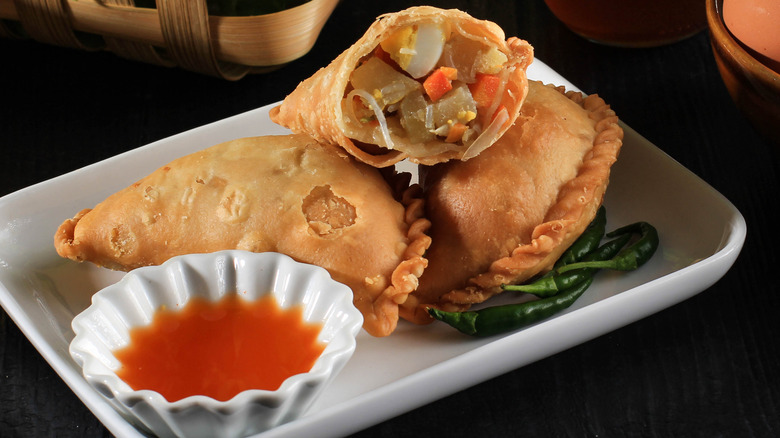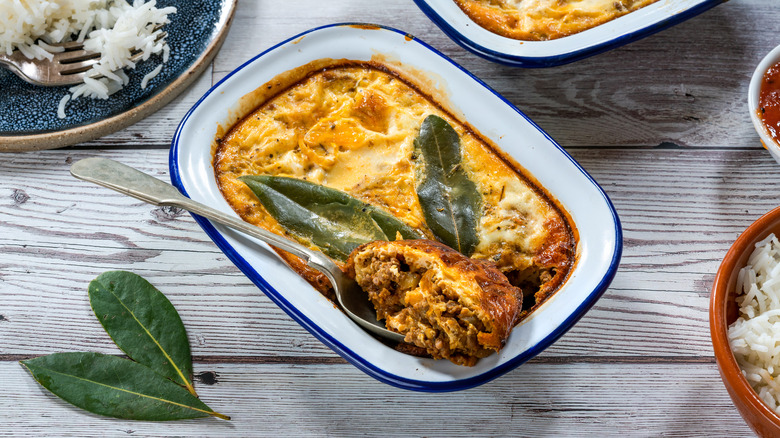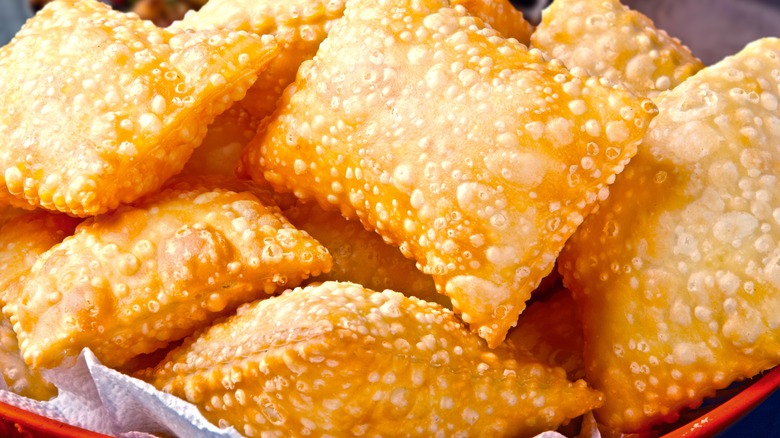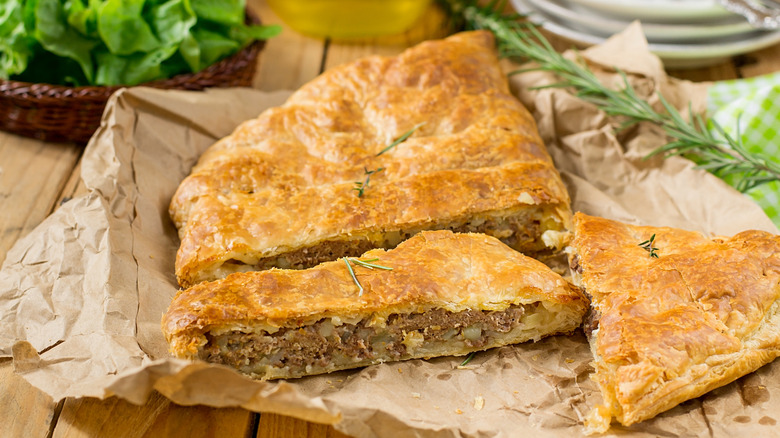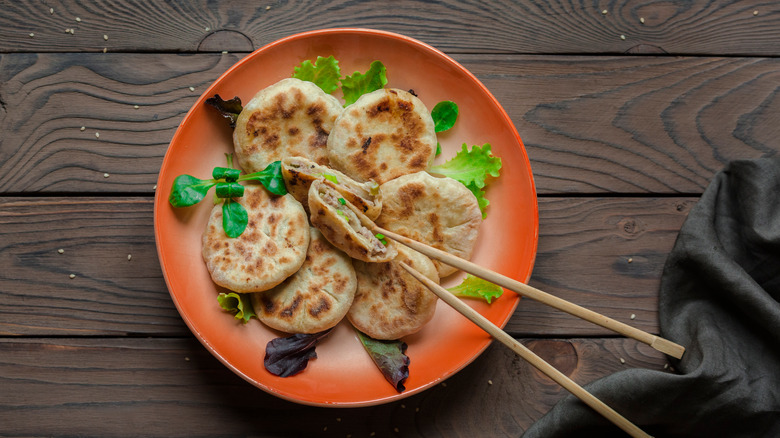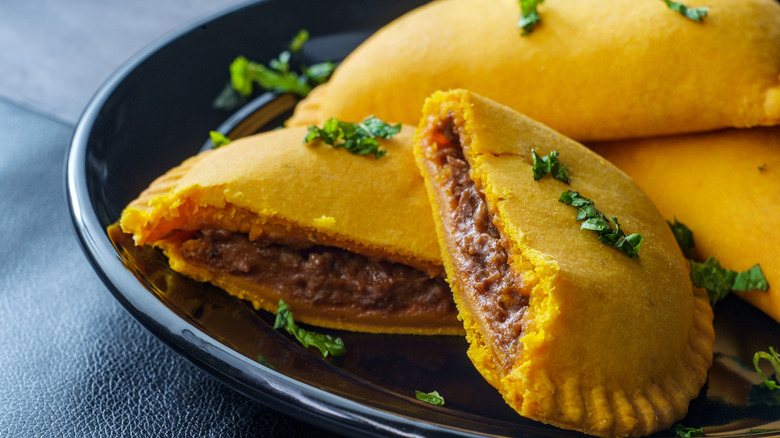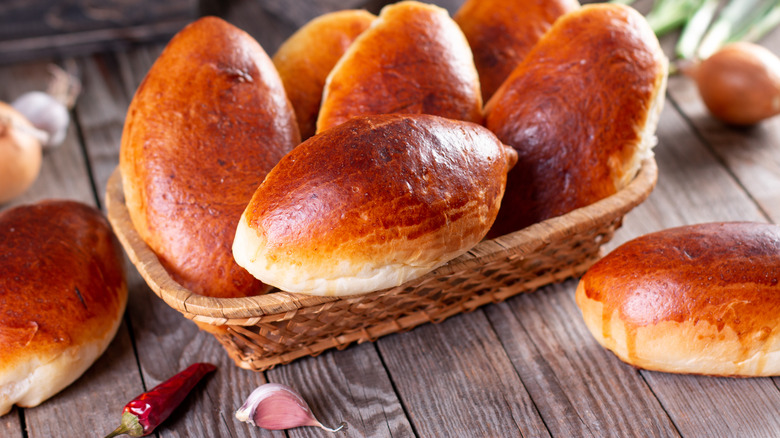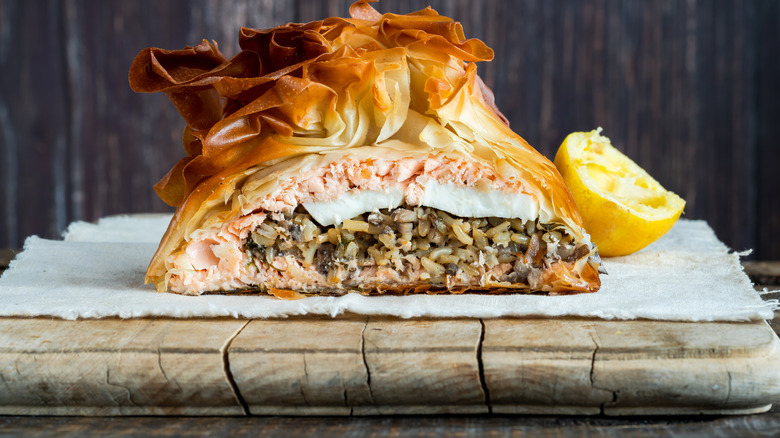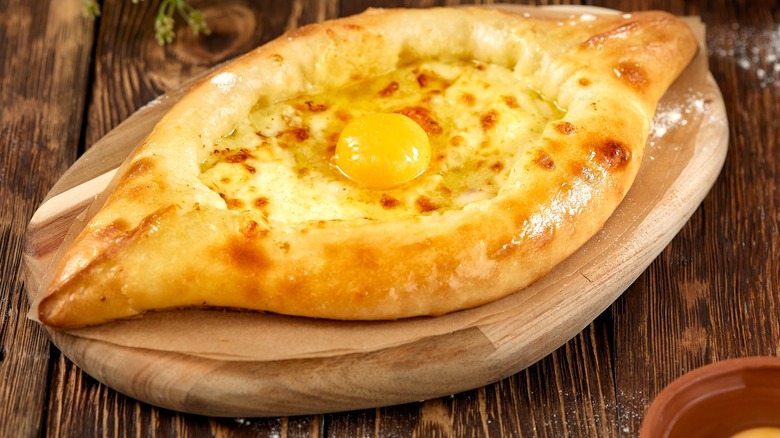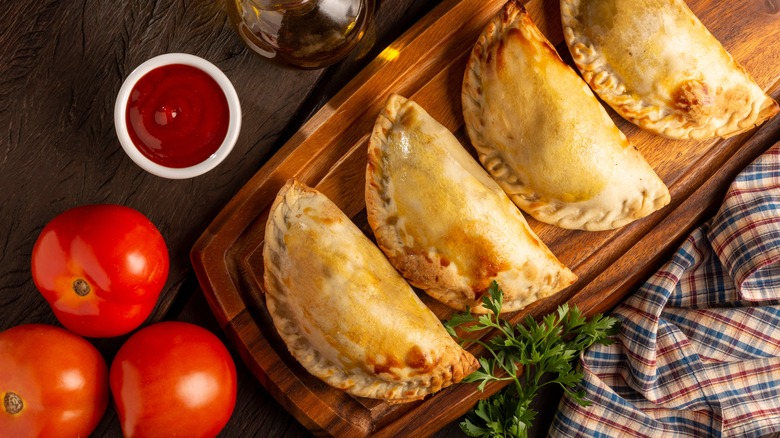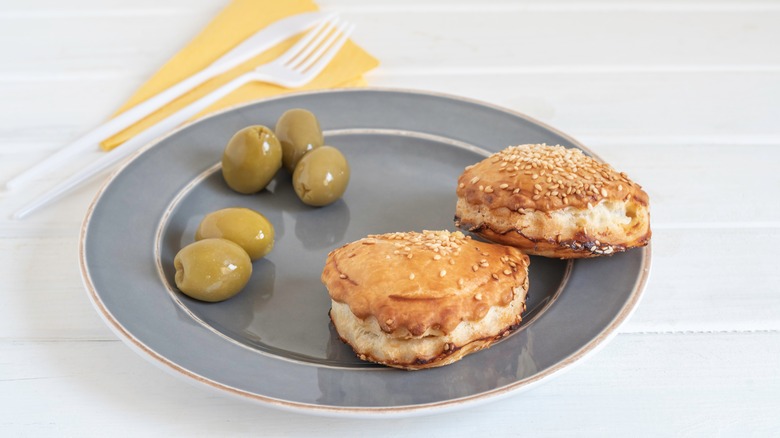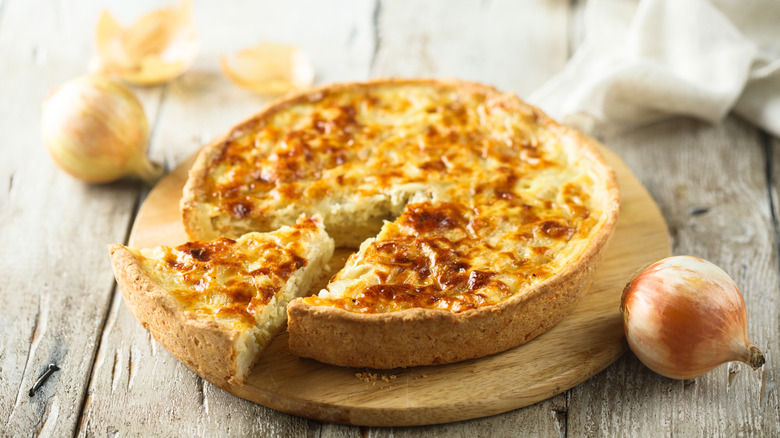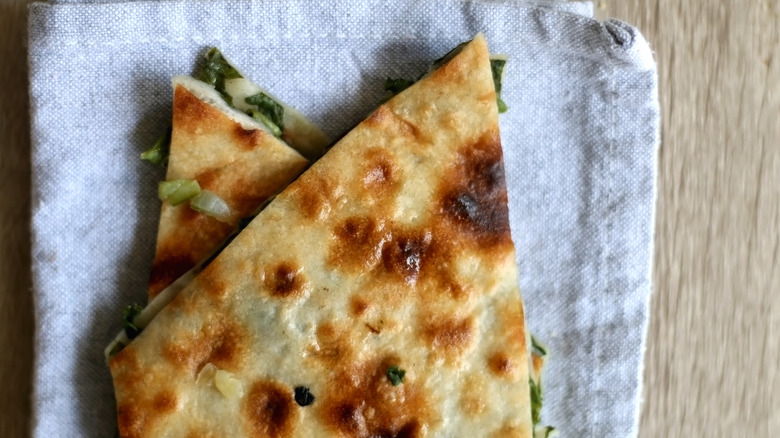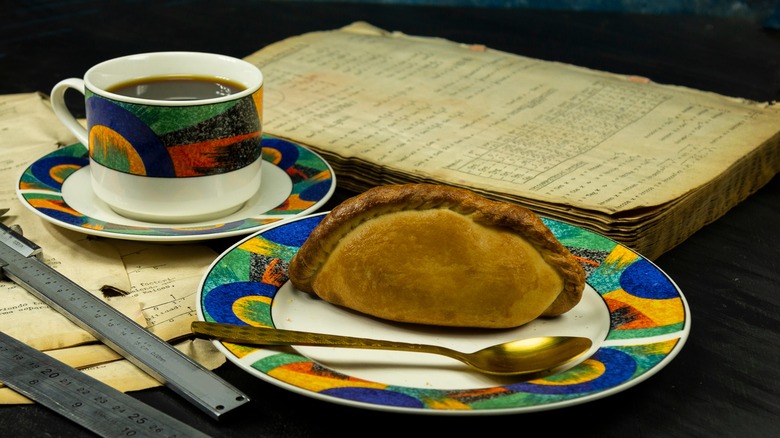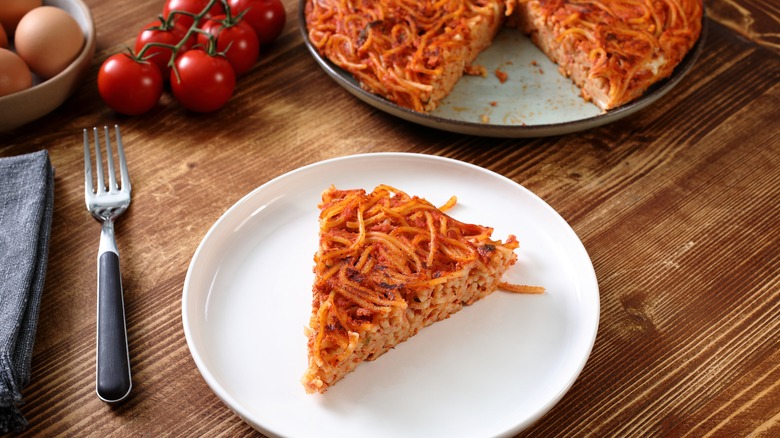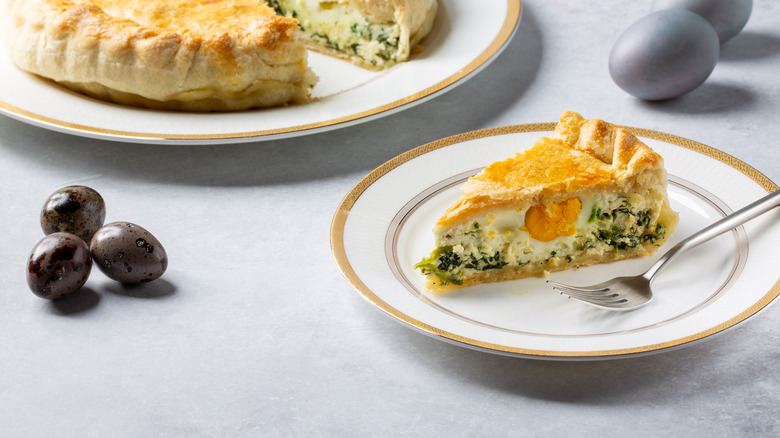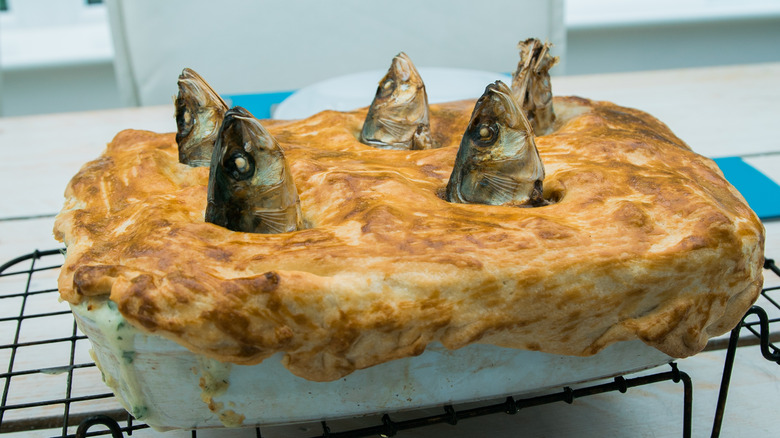Best Savory Pies From Around The World
If you're looking to upgrade your lunchtime sandwich routine or explore new flavors in an easy and portable way, look no further. Everyone loves seeing a pie on the dessert table, but it can be tiring to see the same thing over and over, especially for those who prefer something less sweet on their plate. It's time for apple, blueberry, and coconut cream pies to take a step back and let the savory pie have its turn in the limelight.
From crispy hand pies to the thinnest tarts, every culture has its own version of savory fillings wrapped in crust. There are hundreds of variations highlighting regional cultures and flavors, with spicy, salty, and deliciously bitter all represented. Whether you're looking for a handheld snack exploding with flavor or a show-stopping piece for your next themed dinner party, we've rounded up the best savory pies from around the world so you're always covered.
Chicken pot pie
While the quintessential American pie might be apple, you could make a case that the chicken pot pie shares equal billing to that title. According to Pie Bar, a beloved Georgia institution, the humble pot pie got its start from English settlers. While the British may have preferred steak pies with all the fixings (ale, mushrooms, kidney, etc.), the chicken pie captivated American hearts instead.
Everyone does their pot pie differently, but the chicken stays the same. Most chicken pot pie recipes call for a rich gravy and let you add your favorite vegetables. Top it all off with a buttery crust that begs to be scooped up for the perfect bite, and prepare yourself for this pie to become a favorite hearty meal.
Shepherd's pie
Shepherd's pie is one of the first things most people think of when you ask for a savory pie, but this classic U.K. supper is actually one of the least pie-like. Instead of a crust, shepherd's pie is topped with stiff mashed potatoes, which keeps in moisture and doesn't turn soggy like a normal shortcrust made of flour and butter.
Though most shepherd's pies made in America combine ground beef and mixed vegetables, a proper shepherd's pie, according to English tradition (or at least Jamie Oliver), needs lamb mince. A beef-based pie exists, but it's called a cottage pie in Britain. The name doesn't explain its filling quite as well as shepherd's pie, but in the United States, at least, the two names are interchangeable.
Australian meat pie
Meat pies are a mainstay of British colonial rule, so it's no surprise that they made their way over to the land down under. While relatively similar to the British version, most Australian meat pie recipes make the pies smaller, so they're handheld rather than big enough to eat with a fork and knife. This makes them particularly well suited to school lunch, cementing their popularity.
According to G'day Gourmet, the nation eats 270 million pies a year. They top the pies with tomato sauce or ketchup, mashed potatoes, or even mushy peas and cart them to football games, work, or school. Aussies are passionate about their pies, almost extremely. The Food Standards Australia New Zealand (FSANZ) is an organization part of the Australian government's health department that has actually placed regulations on the definition of this pie. The FSANZ committee states that true Australian meat pies "must contain 25 percent meat flesh" and list any other ingredients contained within the buttery crust on a nutrition label.
Sfiha
Sfiha literally translates to "meat on dough" (via Taste Atlas), and it's the Lebanese answer to the savory pie genre. For fans of döner kebab or gyros, sfiha offers the best of both worlds: pillowy crust and perfectly seasoned meat. Found throughout the Levant, sfiha is a popular street food across the Fertile Crescent.
According to Iraqi author Nawal Nasrallah, this flatbread has a long history of bakeries and food stands serving the open-faced pie since the '70s, after which its popularity only continued to grow. It's usually topped with chopped tomatoes, spiced lamb, and pine nuts, but onions, cheese, and fresh herbs are common additions. The pies are served hot with an assortment of toppings like olive oil, pomegranate molasses, cucumbers, and yogurt.
Pastilla
A good pastilla marries the sweet and savory with ease. According to National Geographic, this pie was introduced to Morocco by the Moors fleeing Spain, which makes sense, as pastilla stems from the Spanish word for "pastry." A flaky crust made of warqa (or warka, Moroccan brick pastry) or phyllo combines with a traditional filling made of pigeon, onion, eggs, and sometimes tomatoes.
In modern times and especially outside of Morocco, chicken tends to replace the traditional pigeon filling. According to Atlas Obscura, this likely has to do with the declining use of pigeons in traditional leather making. Additionally, spices like saffron, cinnamon, and paprika make this skillet pie fragrant and decadent. The completed pie is topped with fried almonds and powdered sugar, creating a sweet crust to complement the rich filling. While pastilla recipes are labor-intensive, they're also a work of art and worth making at least once in your culinary journey.
Spanakopita
If you're a fan of Greek food, it's more than likely you've tried the quintessential spinach pie that's common across the country and in Greek restaurants everywhere. You can make this pie as a slab or a hand pie, but phyllo is the star of the show in both versions.
The filling for spanakopita is a blend of chopped and cooked spinach, feta, and herbs like dill and mint held together with beaten eggs and olive oil. For some adventurous eaters, variations on spanakopita also include chopped Kalamata olives and pine nuts. If you're not feeling so bold, the traditional spanakopita recipe stands on its own as a fantastic lunch or snack option.
Quiche Lorraine
The French are no strangers to pies, and quiche is just one of the delicious options available. Ironically though, quiche Lorraine actually got its start in the medieval German kingdom of Lothringen. According to Atelier Monnier, the French simply enhanced the German kuchen and created the quintessential breakfast. There are endless types of quiche — really, one for every taste — but in its most basic form, a quiche is a baked egg tart with cheese.
Quiche Lorraine is by far the most popular. After all, adding bacon is a quick way to the hearts and stomachs of the masses. For those who prefer a vegetarian or pork-free option, spinach-filled quiche Florentine, sauteed mushroom quiche champignon, and leftover-friendly quiche Provençal are stellar make-ahead meals that can be frozen after baking and then reheated whenever needed.
Karipap
Are you a fan of empanadas, British pasties, or samosas? Try the Malaysian delight that is Karipap. According to the South China Morning Post, the influence of British and Portuguese colonial rule impacted the flavor profiles of Southeast Asia, creating this beloved street food that is enjoyed across Malaysia, Singapore, and Thailand.
While Karipap is like an empanada in shape and size, this flaky hand pie is filled with a thick golden chicken curry and potatoes. You can substitute the curry for any version you prefer. Popular alternatives include Indonesian beef rendang, a nonspicy vegetarian version made of shredded radish and tofu, and tuna or sardines (via Taste Atlas)
Bobotie
Bobotie is a South African staple. According to Food for Mzansi, internet debates have broken out over its contested title as the national dish of South Africa. Bobotie is like a shepherd's pie because it doesn't have a crust made of dough. The pie is filled with a curried beef filling mixed with raisins, walnuts, and chutney, creating a beautiful blend of sweet, savory, and sour.
Bobotie's egg topping takes the place of a top crust or mashed potatoes, and this steamy environment keeps moisture inside the pie. The eggs create a sort of custard on top of the dish and add another layer of texture and flavor to the pie. Are you interested in making bobotie for yourself? Try a traditional bobotie recipe and serve it with spiced yellow rice and a Malaysian chili paste called sambal to add additional heat to the dish.
Karjalanpiirakka
This pie is unique, even beyond its name. Made with a rye crust, karjalanpiirakka is a traditional open-faced pie enjoyed in Finland and Russia. Though the dough makes this pie stand out visually among some others, its filling deserves a closer look.
Traditionally, karjalanpiirakka was filled with a porridge made of cooked barley and rice (via The Slow Food Foundation). In modern times, chefs expanded it to include pureed root vegetables and potatoes. The finished pie is topped with munavoi (egg butter). This Finnish delicacy is a blend of softened butter chopped hard-boiled eggs and is frequently spread over pastries and pies like karjalanpiirakka to add more depth to its flavor.
Pastelitos
We might be biased, but pastelitos — especially from hole-in-the-wall Miami bakeries in the early morning hours — are the perfect meal. They come in endless varieties like pastel de carne, con queso, and con maiz. Without fail, these delightful mini hand pies are the ideal pick-me-up. The dough is fried into bubbly pockets, and fillings often walk the line between savory and sweet.
While a traditional pastel de carne consists of ground beef or steak in a spicy and savory sauce, according to the Maimi New Times, there has been a boom in chefs using creative fillings that mix with traditional flavors. These pies commonly appear at picnics, family gatherings, and workplace meetings around Miami, as well as Cuban and Puerto Rican communities throughout the Americas.
Tourtière
If you've been to Canada, you likely heard of Quebec's favorite pie. According to the Smithsonian Magazine, tourtière is a holiday mainstay for many French Canadians, with the spiced meat pie served most often around Christmas and the new year. The pie is larger than a pot pie or hand pie and is usually served in slices. This makes it perfect for family-style service during holiday parties.
Vermont restaurant 158 Main weighs in on tourtière's ingredient list, stating that the pie is most often made with some combination of pork, beef, and veal. It's also flavored with herbs and spices like sage, thyme, nutmeg, and cloves. These common spices make the pie especially nostalgic for those Quebecois that serve tourtière during the holidays.
Xian bing
Xian bing is a spiced beef pie hailing from China. There are a few contradicting histories for this delicious pie, with minor changes in each version. However, Taste Atlas describes the pie as a flat dough pancake from Northern China filled with spiced beef and green onions. Several versions exist, and the recipes vary throughout China and the world for this popular street food.
Regardless of any conflicting stories, Movable Feasts unifies these variations with the cooking method. The hand pies are pan-fried until they're fully cooked and golden brown, making them crispy on the outside and soft on the inside.
Jamaican beef patty
When traveling to the Caribbean, the beef patty is a Jamaican food you must try. They make the dough with turmeric, giving it a gorgeously unique yellow tint, and the beef filling is sweet and savory. The pie is sold everywhere and is perfect at any time of the day.
From street food stalls to the frozen aisle of grocery stores, Jamaica's patty has taken on a life of its own. In Jamaica, there are only a few main patty companies dedicated to packaging and selling patties to a global market of Jamaican natives and those curious to get a taste of the island's traditions. Everyone has their preference, though, according to an informal survey conducted by Jamaicans.com, Tastee Patties reign supreme as the king of the beef patty.
Piroshki
The ultimate comfort food for many in the Baltic comes in the form of these yeasty hand pies filled with onions, mushrooms, rice, and meat. Not to be confused with Polish pierogi, pirogi (or piroshki) is the Russian term for "feast cakes" (via Babble). They are popular throughout Russia and its bordering countries and have also been introduced to central Asia through immigration.
While sweet fillings like apples, berry jams, and fresh cheeses are popular, piroshki are often filled with fatback, carrots, and eggs and enjoyed as savory lunches. You can even make smaller versions and serve them alongside soups. For those looking to try these delicious pies at home, this classic piroshki recipe from Anya Von Bremzen, author of "Mastering the Art of Soviet Cooking," is stuffed with cabbage and onions.
Coulibiac
French and Russian cuisines have been entangled even prior to the French invasion of 1812, according to Russia Beyond. From Tsar Peter the Great to Empress Catherine the Great, Russian royalty has enjoyed French food, and coulibiac is a marvelous example. According to Fine Dining Lovers, the legendary French chef Auguste Escoffier elevated the traditional dish to impress visiting Russian naval officers in Nice, and the rest is history.
For coulibiac, a buttery crust that's decidedly French envelopes decadent Russian salmon and a variety of fillers, so the salmon steams from the inside, creating perfectly moist fish. Adding onions, buckwheat or rice, and other optional ingredients like herbs and greens ensure that the pie is filling but not too heavy.
Sandwiching fillets of salmon wrapped in delicate puff pastry creates a dish that was traditionally shaped to look like a fish with individual scales. It's well known that coulibiac is one of King Charles' favorite meals. When executed well, it's such a gorgeous presentation, and easy to imagine why this pie is served to both British royalty now and Russian princesses of the past.
Khachapuri
The country of Georgia is famous for its open-faced cheese tart. Khachapuri has taken the internet by storm, and the pie's popularity only continues to grow as more people discover the perfect marriage between buttery cheese, chewy crust, and jammy egg yolks rolled into one. The national dish of Georgia boasts a pillowy yeast dough that's folded around fresh cheeses.
Georgians will usually use a soft local cheese like sulguni, which is a brined cheese similar to mozzarella. However, according to Culture Cheese Magazine, American chefs looking to make khachapuri at home may have to settle for a blend of feta, mozzarella, and havarti to get the perfect flavor and texture.
Empanadas
Empanadas are integral to many cultures and offer so many varieties. It's hard to pick just one to discuss. There are endless recipes to choose from, but the history of empanadas is relatively straightforward. While we associate them with Latin America, the Spanish introduced their much larger version of the empanada to the Americas.
With the different cultures that were present in the Spanish colonies, several variations became local delicacies. Dough and filling ingredients changed based on what was most available. Beef and pork are common fillings, but chicken empanadas are just as popular. Nowadays, it's impossible to claim one empanada version as the best. Like most people, we'll simply say that it's the one our family makes.
Bourekas
Bourekas, borekas, borek, there's a name for everyone when it comes to these beloved Israeli pies. Found throughout countries like Jordan, Turkey, and Iran, bourekas come in an abundance of shapes and flavors. While commonly eaten by Sephardi Jews, according to Taste of Jewish Culture, these delicious hand pies have found themselves enjoyed by people from a variety of cultures and countries.
This universal love of these baked or fried pies filled with meat, cheese, and vegetables has led to a bit of controversy over the years. According to The Times of Israel, the rabbinate actually had to get involved, defining a set shape for each boureka filling in order to help separate dairy from nondairy options. The decision was made that square puff pastry is used for nondairy pies, while triangular puff pastry indicates pies that include dairy.
Zwiebelkuchen
For fans of French onion soup, zweibelkuchen is the pie for you. Originating in Germany, this tart combines the richness of caramelized onions with an eggy custard. According to the American Jewish Historical Society, zweibelkuchen literally translates to "onion cake," though they recognize that it's more like a tart or a quiche.
Where it differs is the crust. It's part short crust and part laminated dough, incorporating eggs and butter to make a rich casing for the filling. Recipes can be found as far back as the 19th century, but be prepared for the occasional mistranslation if you decide to use one that old.
Soparnik
Soparnik is a Croatian delicacy specifically originating in the Split Riviera. The pie actually received a protected geographical indication from the European Union in 2016 (via European Commission), which is similar to an AOP awarded to French wines made in specific areas with strict regulations. This pie closely resembles a flatbread, with chard, garlic, and onions spread between thin layers of dough that are stretched to fit a special board called a sinije.
The pie is then grilled over the coals of a fire, resulting in a beautifully charred crust that's rubbed with garlic before it's sliced into diamonds after cooling slightly. Soparnik is now considered a holiday dish, served at weddings and Christmas, but it's often used as a reminder of the people's strength against past invaders. It's celebrated annually at the festival of soparnik, which takes place in the town of Dugi Rat near Omiš, Croatia.
Salteñas
Bolivia has its own claim to fame with salteñas. This hand pie may look like another variation on the empanada, but it hides a flavorful secret underneath its thick crust. The pie is filled with meats — usually beef or chicken — onions, eggs, olives, and sometimes peas. What never changes, though, is the aspic that's mixed into the filling.
This gelatinous flavor bomb goes into the filling mixture as a solid and melts in the oven's heat, turning into a rich broth that spills out when you bite into it, similar to a soup dumpling. Salteñas are a delicious traditional breakfast in Bolivia, where they're frequently enjoyed with a cup of coffee before work or in a café for brunch.
Spaghetti pie
Where would we be without American invention? We'd likely be without the strange amalgamation of flavors and cultures found in spaghetti pie. It's a vintage recipe, a sort of concoction that could only be found in the '70s as a way to make leftovers stretch or feed an army. Found on the February cover of Better Homes and Gardens in 1974 (via Click Americana), spaghetti pie is a surprisingly delicious-looking vintage stunner.
While it's hard to know exactly where spaghetti pie originated, one thing is for sure: it bears a striking resemblance to an Italian omelet by the name of la frittata di pasta. With the spaghetti omelet born from Neapolitan poverty, it's not surprising that American Italians would bring something similar to the U.S. when they immigrated.
Either way, spaghetti pie is an instant crowd-pleaser that can be adjusted to fit any preference. For instance, Gail Simmons' spaghetti pie recipe contains broccoli, Italian sausage, and a pound of cheese with fresh sage.
Torta pasqualina
Food and culture go hand in hand, and religion and food are often tangled together in the same way. When it comes to pies, torta pasqualina is a delicious example. Originating from Liguria, Italy, and traced back to the 1500s, this torta (or tart) consists of artichokes, ricotta, and whole eggs. While chard may be substituted for artichokes, the whole eggs baked into the filling represent hope and renewal and, according to Vintage Bakehouse, the disciples of Jesus Christ.
The crust itself holds significance, as devout Ligurian bakers insist that the laminated dough must have 33 distinct layers to celebrate each year Jesus was alive on Earth. Most cookbooks call for at least 20 layers, so regardless of your religious affiliation, the crust on a torta pasqualina will be flaky and buttery throughout.
Stargazy pie
While jokes have been made about British food for years, the infamous stargazy pie might make some take good-humored jests to heart. Beneath the smiling faces of sardines or pilchards is a Cornish delicacy rooted in tradition and history. Stargazy pie is a local Christmas tradition in the Cornish fishing village of Mousehole, where indomitable bakers start this pie on December 23rd.
According to local legend, fisherman Tom Bawcock is the inspiration behind stargazy pie, as he bravely sailed out into a storm to catch the fish that his starving village needed to survive a famine. When he returned, he baked the fish into a pie to share with the rest of Mousehole, and the holiday tradition was born to honor him.
Vice states that recipes often call for shredded hard-boiled eggs, parsley, onions, and butter. Regardless of the filling on the inside, this savory pie has a sweet story that can inspire bravery in us all. That is, of course, if you're willing to eat it.
